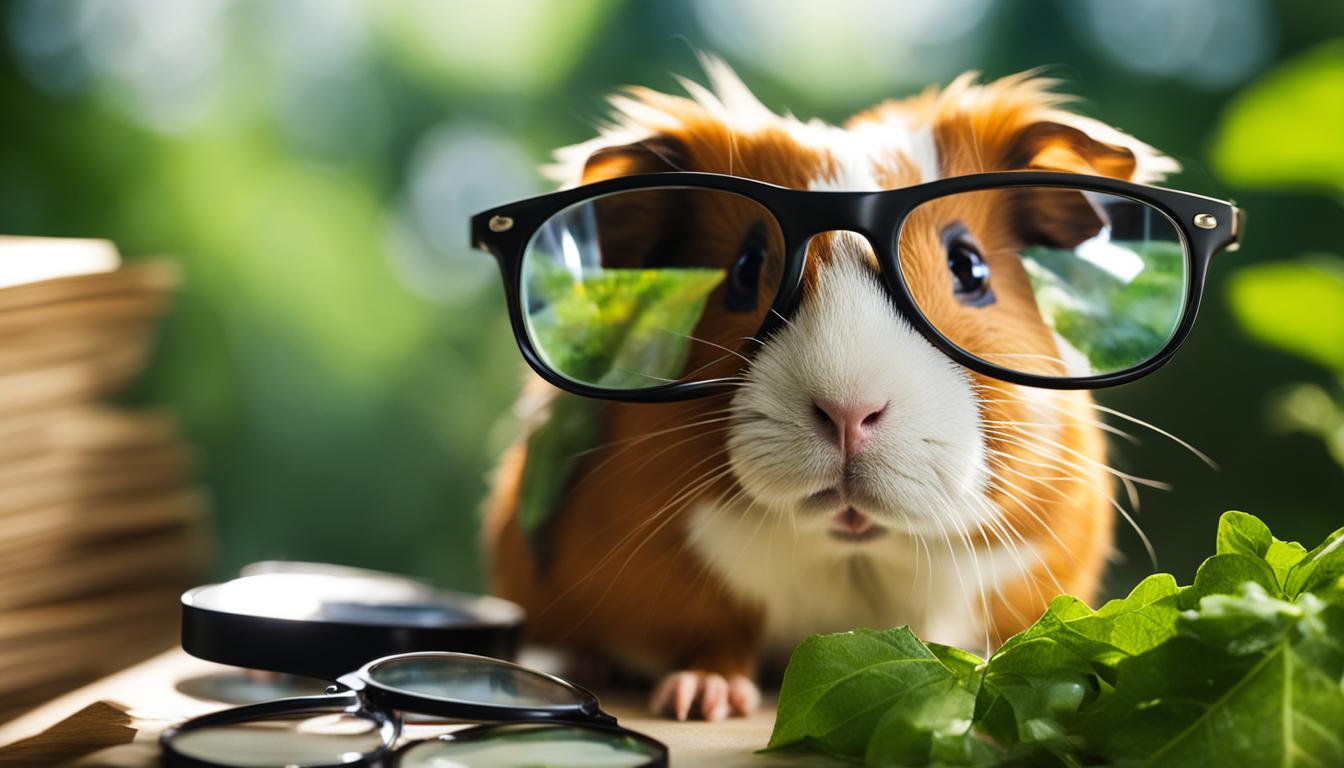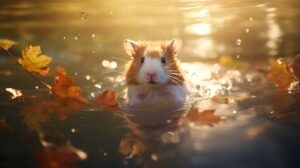Have you ever wondered about the eyesight of guinea pigs? As beloved pets and popular subjects of research, guinea pigs have captivated the curiosity of many.
In this article, we delve into the fascinating world of guinea pig vision to uncover the truth about their ocular abilities and explore how well they can see.
Key Takeaways:
- Guinea pigs have a well-organized, collagen-based lamina cribrosa in their optic nerve head, similar to humans, suggesting good ocular abilities.
- While they have some limitations in visual acuity, depth perception, and low light vision, guinea pigs are still able to navigate their surroundings and rely on their other senses to compensate.
- Regular veterinary check-ups and proper eye care are essential to maintain guinea pig eye health.
- Guinea pigs are increasingly being used as models for studying glaucoma and myopia, providing valuable insights into these eye conditions.
- Guinea pigs are sensitive to both light and temperature, and it is important to provide a suitable environment to ensure their comfort and wellbeing.
Guinea Pig Anatomy and Development of Intraocular Pressure
Understanding the anatomy of guinea pigs is key to unraveling the development of intraocular pressure in these adorable rodents.
Studies have examined the eyes of both pigmented and albino guinea pigs to uncover the intricate structures that contribute to their ocular abilities.
The optic nerve head (ONH) of guinea pigs is remarkable, featuring a well-organized, collagen-based lamina cribrosa.
This lamina cribrosa, which consists of collagen types I, III, IV, and V, elastin, fibronectin, and glial fibrillary acidic protein (GFAP), is similar to that found in tree shrews and even humans.
In addition to the impressive ONH, the adjacent sclera of guinea pigs is primarily composed of crimped collagen fibers.
This unique composition supports the overall stability and integrity of the eye structures. Overall, the guinea pig ONH and sclera resemble those found in humans, highlighting their potential for excellent ocular abilities.
Table:
| Eye Structure | Composition |
|---|---|
| Optic Nerve Head (ONH) | Collagen types I, III, IV, and V, elastin, fibronectin, and glial fibrillary acidic protein (GFAP) |
| Sclera | Crimped collagen fibers |
Through further research on guinea pig anatomy, scientists can delve deeper into understanding the development of intraocular pressure and its implications for ocular health.
This knowledge could ultimately contribute to the advancement of treatments and interventions for various eye conditions in both guinea pigs and humans.
Guinea Pig Eye Health and Care
When it comes to guinea pig ownership, ensuring the health and well-being of their eyes is crucial.
Regular veterinary check-ups are essential to monitor the overall health of their eyes and catch any potential issues early on. Here are some tips for maintaining good guinea pig eye health:
- Keep the cage clean: A clean living environment helps minimize the risk of eye infections. Regularly clean and disinfect the cage to prevent the accumulation of bacteria and debris.
- Avoid aromatic substrates: Some bedding materials contain oils or fragrances that can irritate the eyes. Opt for unscented bedding options to minimize the risk of eye irritation.
- Provide a balanced diet: Guinea pigs require a diet rich in vitamin C to maintain healthy eyes. Ensure they receive sufficient amounts of fresh fruits and vegetables, which are excellent sources of this essential nutrient.
- Monitor behavior and appearance: Pay attention to any changes in your guinea pig’s behavior or appearance that may indicate vision problems. Look for excessive tearing, redness, cloudiness, or discharge, which could be signs of eye infections or diseases.
In addition to these general care practices, it’s important to seek immediate veterinary attention if you notice any persistent or concerning symptoms.
Early intervention can help prevent complications and ensure your guinea pig’s eye health is properly addressed.
Common Guinea Pig Eye Diseases
Guinea pigs can be prone to several eye diseases, including:
- Conjunctivitis: This is inflammation of the conjunctiva, the membrane that covers the front of the eye. It may present with redness, discharge, and excessive tearing.
- Corneal ulcers: These are open sores on the surface of the cornea, typically caused by injury or infection. Symptoms include eye pain, cloudiness, and squinting.
- Cataracts: Cataracts occur when the lens of the eye becomes cloudy, leading to impaired vision. They may develop due to genetic factors, aging, or underlying health conditions.
If you suspect your guinea pig may be experiencing any of these conditions, it’s crucial to consult with a veterinarian who can provide a proper diagnosis and recommend an appropriate treatment plan.
Remember, taking proactive steps to maintain guinea pig eye health can significantly contribute to their overall well-being and quality of life.
| Signs of Healthy Guinea Pig Eyes | Signs of Eye Problems |
|---|---|
| Bright and clear eyes | Redness or swelling around the eyes |
| No excessive tearing or discharge | Cloudiness or opacity in the eyes |
| No squinting or blinking | Excessive tearing or discharge |
Guinea Pig Vision and Visual Acuity
Guinea pigs have unique visual abilities that differ from humans. While they possess a good sense of vision, their visual acuity is limited compared to ours.
One aspect of guinea pig vision is their color perception. Unlike humans, who have trichromatic vision and can perceive a wide range of colors, guinea pigs have dichromatic vision.
This means they can only distinguish between shades of blue and green, and have difficulty perceiving reds and oranges.
So, while a bright red carrot may appear less vibrant to a guinea pig, the distinction between different shades of green will be clearer to them.
Another interesting aspect of guinea pig vision is their depth perception. Guinea pigs have poor depth perception compared to humans.
They rely more on their sense of smell and hearing to navigate their surroundings. This is because their eyes are positioned on the sides of their heads, giving them a wider field of view but sacrificing depth perception.
So, while they may not be as adept at judging distances, they make up for it with their other heightened senses.
Table: Guinea Pig Visual Abilities
| Visual Ability | Guinea Pig | Human |
|---|---|---|
| Color Vision | Dichromatic (blue and green perception) | Trichromatic (perceives a wide range of colors) |
| Depth Perception | Poor | Good |
| Low Light Vision | Adapted, but not as strong as nocturnal animals | Highly adapted |
Guinea pigs also have some ability to see in low light conditions. However, their eyes are not as well-adapted for night vision as some other animals, such as cats or owls.
They can navigate in dimly lit environments, but their visual acuity may decrease in very low light situations.
In conclusion, guinea pigs have unique visual abilities that are different from humans. While they have limitations in visual acuity, color perception, depth perception, and low light vision, they are still able to navigate their surroundings effectively and rely on their other senses to compensate.
Understanding the intricacies of guinea pig vision contributes to our knowledge of sensory adaptations in different species and helps us provide appropriate care and enrichment for these beloved pets.
Guinea Pig Glaucoma and Myopia Research
The guinea pig is increasingly being recognized as a valuable model for studying glaucoma and myopia, two common eye conditions.
Researchers have found that the guinea pig’s ocular characteristics closely resemble those of humans, making it an ideal model for investigating the underlying mechanisms and potential treatments for these conditions.
Glaucoma, a disease characterized by increased intraocular pressure and damage to the optic nerve, affects millions of people worldwide.
By studying glaucoma in guinea pigs, researchers can gain a better understanding of the disease progression and test novel therapeutic interventions.
Guinea pigs have been found to have a collagen-based lamina cribrosa in their optic nerve head, similar to that of humans, which suggests that they may experience similar ocular changes in response to increased intraocular pressure.
Similarly, guinea pigs have been found to exhibit myopia, or nearsightedness, a condition characterized by difficulty seeing distant objects clearly.
Studying myopia in guinea pigs can provide insights into the underlying mechanisms of the condition and help develop strategies for prevention and treatment.
Their visual acuity and refractive errors can be measured using specialized techniques, allowing researchers to explore the factors contributing to myopia development in humans.
Using guinea pigs as models for glaucoma and myopia research not only allows for a better understanding of these conditions but also offers potential avenues for the development of new treatments and interventions.
By utilizing the guinea pig’s similarities to humans in terms of eye structure and function, researchers can make significant strides in advancing our knowledge of these eye diseases.
Guinea Pig Sensitivity to Light and Temperature
Guinea pigs are highly sensitive to both light and temperature. Understanding their sensitivity is crucial for providing them with a suitable and comfortable environment.
Light Sensitivity: Guinea pigs have eyes that are adapted to bright daylight. While they can see in low light conditions, their visual acuity is not as well-developed as some other animals.
It’s important to avoid exposing them to excessively bright or direct sunlight, as it can cause discomfort and potential damage to their eyes.
Temperature Sensitivity: Guinea pigs are prone to overheating and are susceptible to heatstroke. They should be housed in well-ventilated cages with solid bottoms to prevent heat buildup.
High humidity can exacerbate their sensitivity to elevated temperatures, so it’s important to ensure proper ventilation and temperature regulation in their living environment.
Guinea pigs should also have access to shade and cool areas to retreat to when they feel too warm.
Guinea Pig Heat Index
A guinea pig heat index can be a helpful tool for understanding their sensitivity to temperature. This index takes into account both temperature and humidity levels to determine the potential risk of heat stress.
It can guide guinea pig owners in providing appropriate cooling measures during hot weather conditions.
Monitoring the heat index regularly and taking necessary precautions can help prevent guinea pigs from experiencing discomfort or heat-related illnesses.
Overall, guinea pigs’ sensitivity to light and temperature highlights the importance of creating a suitable environment for their well-being.
By providing proper lighting conditions and ensuring temperature regulation, you can help your guinea pig thrive and enjoy a comfortable living space.
Guinea Pig Breeds and Coat Colors
If you’re considering getting a guinea pig as a pet, you’ll be delighted to know that there are various breeds to choose from, each with its own unique characteristics and appearance.
Whether you prefer a short-haired guinea pig or one with a long and flowing coat, there’s a breed out there that will capture your heart.
One popular breed is the American guinea pig, known for its smooth and glossy coat. These guinea pigs have a friendly and outgoing personality, making them great companions for families.
If you’re looking for something a little more exotic, you might be interested in the Abyssinian guinea pig.
This breed has a unique coat with multiple rosettes, giving them a distinctive and eye-catching appearance.
For those who enjoy grooming and taking care of a guinea pig’s coat, the Peruvian breed might be a perfect choice.
These guinea pigs have long, silky hair that requires regular brushing to keep it looking its best. If you’re looking for something truly special, you might consider the Silkie guinea pig.
This breed has a long and curly coat that resembles a fluffy ball of fur.
When it comes to coat colors, guinea pigs come in a wide variety of shades. From the classic black and white to the more unusual combinations like tortoiseshell and brindle, there’s a guinea pig with a coat color that will suit your taste.
Whether you prefer a solid color or a patterned coat, you’ll find a guinea pig that will bring joy and companionship into your life.
| Breed | Coat Description |
|---|---|
| American | Short and smooth coat |
| Abyssinian | Coat with multiple rosettes |
| Peruvian | Long and silky hair |
| Silkie | Curly and fluffy coat |
Guinea Pig Lifespan and Physical Characteristics
Average Lifespan: Guinea pigs have a lifespan of around 4 to 8 years, with some individuals living longer.
Size and Weight: When fully grown, guinea pigs are larger rodents, weighing between 700 to 1200 grams.
Physical Characteristics: Most guinea pigs have fur, which varies in color and texture depending on the breed. However, there is also a hairless breed called the skinny pig.
| Characteristics | Description |
|---|---|
| Fur | Most guinea pigs have a thick coat of fur that comes in various colors and patterns. The Abyssinian breed has a unique “rosette” pattern, while the Silkie breed has long, silky hair. |
| Skinny Pig | Unlike other guinea pig breeds, the skinny pig is hairless and has smooth skin. They require special care to protect their delicate skin from the sun and cold. |
| Size | Guinea pigs come in different sizes, with some breeds being smaller than others. The American breed is known for its medium size, while the Peruvian breed is larger with long hair that can reach up to 20 inches in length. |
In conclusion, guinea pigs have a lifespan of 4 to 8 years and come in various sizes with different physical characteristics. Most guinea pigs have fur, but there is also a hairless breed called the skinny pig. Their fur comes in different colors and patterns, depending on the breed. Understanding the lifespan and physical characteristics of guinea pigs is important for their proper care and well-being.
Guinea Pig as a Model Animal for Research
Guinea pigs have been long recognized as valuable model animals for scientific research. Their unique anatomical and physiological characteristics make them suitable for studying a wide range of medical conditions. Guinea pigs have been used in experimental studies related to diabetes, tuberculosis, scurvy, and pregnancy complications, among others.
Guinea pigs serve as a bridge between rodents, such as mice and rats, and larger mammals, including humans. Their anatomical similarities to humans, especially in terms of their optic nerve head and lamina cribrosa structure, have made them particularly useful for investigating eye diseases and ocular conditions.
Researchers have leveraged the guinea pig model to gain insights into the development, progression, and treatment of various eye conditions. These experimental studies have paved the way for advancements in ophthalmology and contributed to our understanding of human ocular health. Guinea pigs continue to play a vital role in ongoing medical research, offering valuable contributions to the field.
| Advantages of Guinea Pig as a Model Animal for Research | Disadvantages of Guinea Pig as a Model Animal for Research |
|---|---|
|
|
While other rodent models have gained popularity in recent years, guinea pigs remain a valuable asset in the realm of experimental research.
Their unique ocular characteristics and their contribution to the understanding of various medical conditions make them an important model animal for scientific investigations.
Conclusion
Guinea pigs have good eyesight compared to other rodents. Their optic nerve head contains a well-organized, collagen-based lamina cribrosa, similar to that of humans, indicating promising ocular abilities.
Although their visual acuity is limited and they have poor depth perception, guinea pigs are still able to navigate their surroundings effectively by relying on their other senses.
While guinea pigs may not see as well as humans, their unique ocular characteristics make them a valuable model for studying eye conditions.
Further research on guinea pigs can contribute to our understanding of diseases like glaucoma and myopia and potentially lead to improved treatments and interventions.
It is important to provide proper care for guinea pig eyes to ensure their overall health. Regular veterinary check-ups, maintaining a clean environment, and providing a balanced diet with sufficient vitamin C are essential.
Monitoring their behavior and appearance for any signs of vision problems or cataracts is also crucial for their well-being.
In conclusion, guinea pigs possess good eyesight and ocular abilities compared to other rodents. Their unique eye structure and characteristics make them an interesting subject for research, contributing to our understanding of various eye conditions and potentially leading to advancements in eye care.
FAQ
Do guinea pigs have good eyesight?
Yes, guinea pigs have good eyesight. They have a well-organized, collagen-based lamina cribrosa in their optic nerve head, similar to that of humans. This suggests that they have good ocular abilities.
How can I take care of my guinea pig’s eyes?
To take care of your guinea pig’s eyes, it is important to provide regular veterinary check-ups, keep the cage clean to minimize the risk of infections, avoid substrates with aromatic oils, provide a well-balanced diet with sufficient vitamin C, and monitor your guinea pig’s behavior and appearance for any signs of vision problems or cataracts.
Can guinea pigs see in low light conditions?
Guinea pigs have some ability to see in low light conditions, but their eyes are not as adapted for night vision as some other animals. They rely more on their sense of smell and hearing.
What eye diseases are guinea pigs prone to?
Guinea pigs are vulnerable to eye problems, such as infections and diseases. Regular veterinary check-ups are important to ensure the overall health of their eyes.
How long do guinea pigs live?
Guinea pigs have a lifespan of around 4 to 8 years, with some individuals living longer.
What are some common guinea pig breeds?
Some common guinea pig breeds include the American, Abyssinian, Peruvian, and Silkie. Each breed has its own unique characteristics and appearance.
Are guinea pigs used in research?
Yes, guinea pigs have been used in biological research for centuries and have contributed to the understanding of various human medical conditions. They are still used as models for studying diseases and have their place in experimental studies.
Do guinea pigs have good visual acuity?
Guinea pigs have limited visual acuity compared to humans. They have dichromatic vision and poor depth perception. They rely more on their sense of smell and hearing to navigate their surroundings.
Are guinea pigs sensitive to light and temperature?
Yes, guinea pigs are sensitive to both light and temperature. They should be housed in well-ventilated cages with access to shade and cool areas to ensure their comfort and wellbeing.
What are the physical characteristics of guinea pigs?
Guinea pigs are larger rodents, weighing between 700 to 1200 grams when fully grown. They come in various sizes, with different breeds having different physical characteristics and coat textures.




